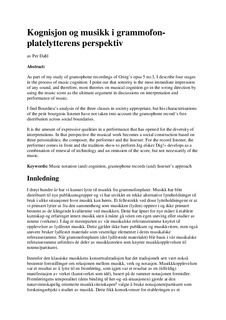| dc.contributor.author | Dahl, Per | |
| dc.date.accessioned | 2013-08-12T07:33:28Z | |
| dc.date.available | 2013-08-12T07:33:28Z | |
| dc.date.issued | 2007 | |
| dc.identifier.citation | Dahl, P. (2007) Kognisjon og musikk i grammofon-platelytterens perspektiv. Studia Musicologica Norvegica, 33, pp. 80-101 | no_NO |
| dc.identifier.issn | 1504-2960 | |
| dc.identifier.uri | http://hdl.handle.net/11250/185896 | |
| dc.description.abstract | As part of my study of gramophone recordings of Grieg’s opus 5 no.3, I describe four stages in the process of music cognition. I point out that sonority is the most immediate impression of any sound, and therefore, most theories on musical cognition go in the wrong direction by using the music score as the ultimate argument in discussions on interpretation and performance of music. I find Bourdieu’s analysis of the three classes in society appropriate, but his characterisations of the petit bourgeois listener have not taken into account the gramophone record’s free distribution across social boundaries. It is the amount of expressive qualities in a performance that has opened for the diversity of interpretations. In that perspective the musical work becomes a social construction based on three personalities; the composer, the performer and the listener. For the record listener, the performer comes in front and the tradition «how to perform Jeg elsker Dig!» develops as a combination of renewal of technology and an omission of the score, but not necessarily of the music. | no_NO |
| dc.language.iso | nob | no_NO |
| dc.publisher | Universitetsforlaget | no_NO |
| dc.subject | musikk | no_NO |
| dc.subject | music notation | no_NO |
| dc.subject | music cognition | no_NO |
| dc.subject | gramophone records | no_NO |
| dc.subject | listening | no_NO |
| dc.title | Kognisjon og musikk i grammofon-platelytterens perspektiv | no_NO |
| dc.type | Journal article | no_NO |
| dc.type | Peer reviewed | no_NO |
| dc.subject.nsi | VDP::Humanities: 000::Musicology: 110 | no_NO |
| dc.source.pagenumber | 80-101 | no_NO |
| dc.source.volume | 33 | no_NO |
| dc.source.journal | Studia Musicologica Norvegica | no_NO |
